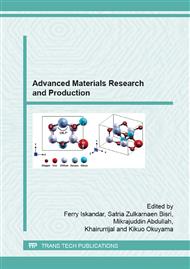p.506
p.510
p.515
p.519
p.524
p.528
p.533
p.538
p.542
Utilization of the Ibai River Sediment as a Raw Material for Producing Ceramic Glazes
Abstract:
Glazes is a layer of vitreous substance, which is combined to ceramic object through a firing process. The aim of this study is to evaluate the potential of Ibai River sediment as raw material for producing ceramic glazes. Minerals and heavy metal in sediment have been characterized using Atomic Absorption Spectroscopy (AAS) and X-Ray Fluorescence (XRF). Glazes formulation has been studied by adding CaCO3 and stoneware into the sediment at different compositions. Glazes sample was tested for chemical resistance and thermal shock resistance. The AAS results show that sediment contains high Fe content of 65.5000 ppm while amount of Cr, Co and Pb are less than 0.4850 ppm. XRF analysis shows that the presence of important minerals in sediment, which is commonly found in commercial glazes formulation and contributes to formation of good glazes. Matte glazes can be obtained by using only sediment while shiny glaze can be obtained by adding CaCO3 to the sediment as fluxs. High concentration of iron in sediments contributed to brown or reddish brown in color of glazes products. The results show that the glazes produced has chemical resistance towards acids and high thermal shock resistance. As a conclusion, the Ibai River sediment is highly suitable to supply abundant and cheap raw materials for producing decorative ceramic glaze for small-scale ceramic industry in Terengganu, which generate new economic source for local community.
Info:
Periodical:
Pages:
524-527
Citation:
Online since:
July 2015
Authors:
Keywords:
Price:
Сopyright:
© 2015 Trans Tech Publications Ltd. All Rights Reserved
Share:
Citation:


